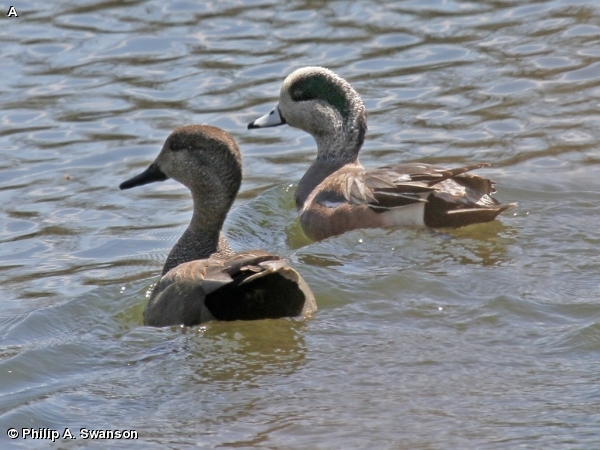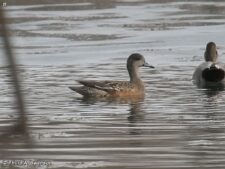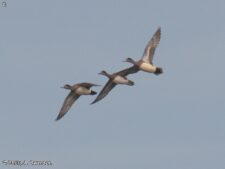
21 inches long with a 33 inch wingspan. The American Wigeon is a medium-sized dabbling duck with a blue-gray bill that has a black tip. This bird has a steep forehead that is very noticeable. The belly is white. In flight the male has a large white patch on the upper forewing and a green speculum. In breeding plumage the adult male has a prominent white crown. The face and neck are mottled gray with a large green ear patch extending behind the eye. The back is dark brown and the flanks and breast are rusty brown. There is a white patch at the rear portion of the flanks. The undertail coverts are black. The female has a mottled brown body with rusty flanks that contrast with a paler head and neck. She also has a dusky eye patch. The non- breeding males and juveniles look like a female.
The American Wigeon is a fairly common spring and fall migrant showing up in early March through April and again from mid-September through late November. They are most often seen flying over the floodplain and at the Great Marsh.
The American Wigeon is sometimes called a baldpate due to its broad white crown. It has one of the furthest north breeding ranges of dabbling ducks from the Bering Sea to Hudson Bay from the edge of the tundra to the Canadian Prairies. Its diet consists largely of plant material. On the water during the winter they may be closely associated with American Coots and various species of diving ducks such as Redheads. They then steal the plant material brought to the surface by these species as they themselves are not proficient divers. The population has rebounded after a decline in the 1980s due to drought in the prairies. Males have a distinctive three syllable whistling call in which the middle note is higher than the others.
Disclaimer: The content of NatureSearch is provided by dedicated volunteer Naturalists of Fontenelle Forest who strive to provide the most accurate information available. Contributors of the images retain their copyrights. The point of contact for this page is: Phil Swanson.





